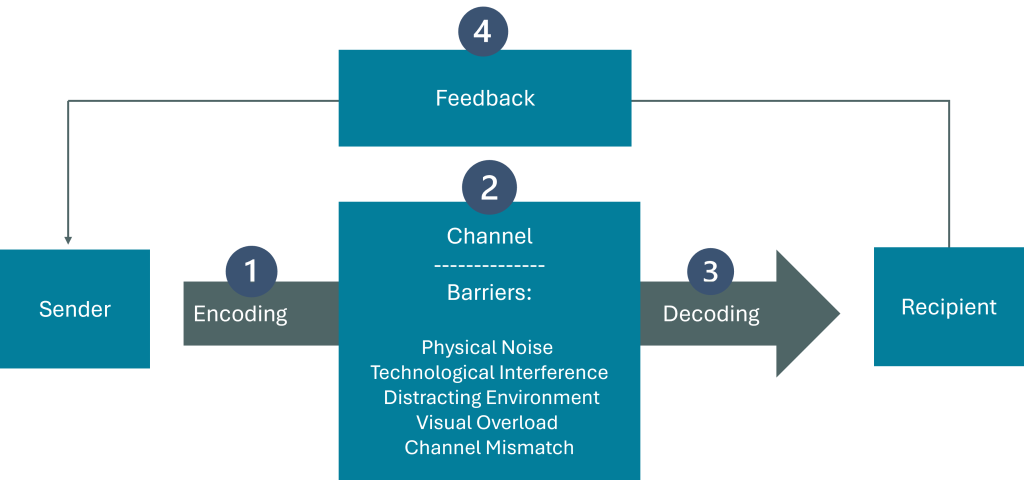8.2 Communication

Communication is the process of conveying information between two or more people. It has existed for as long as humans have, and it underpins not only our personal relationships but also our academic, professional, and societal interactions. While communication takes countless forms across different cultures and species, this chapter focuses on two primary categories relevant to human interaction: verbal and non-verbal communication.
Verbal Communication
Verbal communication involves the use of words or language. Such words can be spoken, written, or symbolically represented in two ways.
Oral Communication
Oral communication is the spoken conveyance of a message using patterns of sound or language.
Meanings can be literal (dictionary definitions) or connotative (implied or emotional undertones). For example, telling someone they are “literally slaying right now,” does not mean they are battling dragons. The word ‘slaying’ in this context means they look amazing and are performing really well—that’s the connotation, not the literal meaning.
Examples: speeches, conversations, laughter, and song.
Written Communication
Written communication is the conveyance of a message through written words, symbols, or drawings.
Like oral communication, meanings can be literal or connotative. For example, the word “home” literally refers to the place where someone lives, but connotatively it can imply warmth, comfort, and a sense of belonging.
Examples: text messages, emails, emojis, symbols, or letters.
Non-verbal Communication
Non-verbal communication involves conveying information through non-linguistic representations. It can be subtle yet powerful, often shaping how verbal messages are interpreted.
Examples: Body language, facial expressions, eye contact, gestures, posture, paralinguistics (tone, pitch, volume), clothing choices, and more.
Key Characteristics:
- Ambiguous: Non-verbal cues can be interpreted in various ways and may contradict verbal messages.
- Omnipresent: Non-verbal signals occur in every interaction, whether we notice them or not.
- Multifunctional: Multiple non-verbal channels often operate simultaneously, sending complex messages.
Five Key Roles of Non-verbal Communication
- Repetition: Reinforces and strengthens a verbal message. (e.g., Saying, “Let’s go over there,” while also pointing in the same direction.)
- Contradiction: Contradicts a verbal message, potentially suggesting insincerity or confusion. Saying, “I’m totally relaxed,” but tapping your foot nervously and avoiding eye contact.
- Substitution: Completely replaces a verbal message. Example: Instead of saying “yes,” simply nod your head in agreement.
- Regulation: Manages the flow of conversation. Example: Raising your hand in a group discussion to signal you’d like to speak next, prompting others to pause and give you the floor.
- Accenting: Draws attention to specific parts of a message. Example: Placing extra vocal emphasis on a key word—e.g., “This point is crucial”—while briefly leaning forward or using a hand gesture to highlight its importance.
Communication Process

Image Description
- Step 1: Sender encodes a message
- Step 2: Message is sent through a channel including barriers
- Step 3: Receiver decodes message
- Step 4: Recipient sends feedback to the sender
This process consists of the steps we take to achieve successful communication. Each step carries potential pitfalls that can distort or change the message. See the steps below to learn more about each one.
Step 1: Sender encodes a message
The sender shapes the message in a form intended for the recipient, choosing specific words, tone, or non-verbal cues suitable to the context.
Step 2: Message is sent through a channel
The channel is a metaphorical pathway through which the message travels. This might include the physical environment, technology (e.g., email, text), or face-to-face interaction.
Step 3: Receiver decodes and interprets message
The receiver interprets the message through their own experiences, emotions, cultural background, and biases.
Step 4: Receiver sends feedback
The receiver responds verbally and/or non-verbally, creating a loop that mirrors the entire process again. Feedback can be intentional (e.g., asking clarifying questions orally) or unintentional (e.g., facial expressions, body language).
Potential Barriers
Ongoing dialogue and awareness of potential barriers help ensure a more accurate exchange. Here are some potential physical barriers which may distort the message:
- Physical Noise: A construction site next door creates loud banging and drilling, making it hard for people to hear each other clearly, even if they’re speaking face-to-face.
- Technological Interference: A video conference call keeps cutting out due to poor internet connection, causing the speaker’s words to drop mid-sentence.
- Distracting Environment: In an open-plan office, multiple conversations and ringtones distract team members from focusing on the intended message.
- Visual Overload: A busy PowerPoint slide crammed with text, images, and animations can overwhelm the audience, making it tough to pinpoint the key message.
- Channel Mismatch: Sending a lengthy, detailed message via text message or group chat, where it might get lost among quick, casual replies instead of being delivered in a more appropriate format (like email or a formal report).
Activity
Click on the cards to learn how the interpretation of the message can lead to misunderstandings.
Text Description
- Jargon: Using specialized technical terms in a workplace memo that non-experts can’t understand.
- Emotional Barriers: Receiving critical feedback right after a personal disappointment, leading to defensive misinterpretation.
- Taboo Topics: Discussing political or religious views in a setting where such topics are sensitive, causing discomfort or miscommunication.
- Language Barrier: A non-native speaker misunderstanding idiomatic expressions like “break a leg” or “hit the ground running.”
- Cultural Differences: One culture views direct eye contact as respectful, while another sees it as aggressive, leading to conflicting interpretations.
Communication Techniques to Influence People
Effective communication is not only about exchanging information but also about positively influencing others. Drawing on concepts from Dale Carnegie’s classic book How to Win Friends and Influence People, consider the following (Carnegie, 1936):
- Never criticize, condemn, or complain. People naturally resist criticism and rarely change due to condemnation. Instead of focusing on faults, seek to understand and guide them positively.
- Give honest and sincere appreciation. Recognizing others’ efforts and qualities—without resorting to flattery—helps them feel valued and builds goodwill.
- Instead of pushing your own desires, find out what the other person wants and align your goals with their interests to create mutual benefit.

